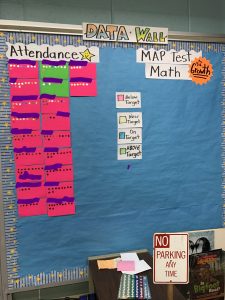(Click pic for a better view. I put the wacky purple streaks in above to disguise names written by hand by students on the cards that show their MAPTM –— Measures of Academic Progress benchmark test — score progress — or lack of progress. Data walls are all the rage now. If you are “Purple Streak Number Eight, you can see exactly how you are doing in comparison to everyone else. You can see that you have four stars and “Norman” has eleven. These kids are third graders. They know exactly where they stand in relation to other students in the class. Some rooms use codes or numbers to disguise student names, but in my experience everyone quickly learns everyone else’s code, especially in early elementary rooms. These are kids who tattle when their seat partner touches someone else’s pencil, after all. Tattling and sharing are second nature to early elementary-age kids. Older kids just enjoy code breaking and uncovering secrets.)
I never suffered from test anxiety in elementary school, middle school, or high school. I might have had nervous testing periods, but I was never afraid to go to class or even school because I had a test. I had the advantage of being good at tests, but I also had the advantage of being young during a saner time. I never spent weeks preparing for an annual state test. I was never told those results might affect my entire future.
I also took a lot fewer tests, and tests that offered more chances for success. Spelling tests and many math tests never required “critical thinking” skills. I had to remember where the letters went. I had to know the order of mathematical operations. By studying, I could be ready for my test. I expected no curveballs. The spelling words were the spelling words, and I could prepare myself or not. My tests seldom required critical thinking in elementary school. By middle school, questions were becoming tougher. What was the advantage to separation of powers in the Constitution? What were some possible disadvantages? I might have to give at least three examples and explain my reasoning. But I was older. I was ready for critical thinking challenges.
My journey into the past stems from this morning’s musing. I know a scared graduate student who just finished five one-hour math finals in two days. I am watching text messages flow out to support this girl who is terrified she may have failed “too many” questions. She was terrified going into those tests. She has been worried all semester.
I wonder how many students are feeling like this girl. How many young men and women have been set-up by testing today? The current emphasis on data has led to a great many more “important” tests. When teacher evaluations, retention and bonuses become based on test score improvements, teachers naturally attempt to get students to take all benchmark and state tests extremely seriously. The topic never drops away for any length of time. Those benchmark scores are often seen on data walls like the one above.*
Eduhonesty: Before we get too rah-rah hoo-hah about the joys of data, I’d like to ask teacher readers and others to put themselves in the shoes of four-star boy. Or even eleven-star boy. What are we doing to these kids?
Schools are teaching resilience and coping skills today as never before. My great fear, however, is that resilience may not always be teachable. Yes, I benefit from meditation. My students benefit from exercise, yoga and positive affirmations. But we all exist in many different continua and in spaces along different spectra. Anxiety disorders are spectrum disorders, for example. That’s why some people take no Prozac, while others suffering from panic disorder may start at an initial dose of 10 mg orally once a day, increased after one week to 20 mg orally once a day. A number will end up taking the listed daily maximum dose of 60 mg orally.
How much and how often are we scaring our students? We don’t know. For that matter, how stupid are we making them feel? How inferior? How lost and even sometimes panicked?
We desperately need to rein in this newfound thirst for Data. Readers, please search “drugs taken for severe test anxiety.” The drugs of choice are beta blockers, benzodiazepines, and antidepressants. The first two classes of drugs can be taken the day of the test, but antidepressants become a daily commitment. Benzodiazepines like Xanax also carry risks of dependency. By high school, too many kids are reaching for these last resorts, or a simple bong if all else fails.
And all this data that districts suddenly think they need? We got along without that data thirty years ago and our students today do not seem to know appreciably more than students thirty years ago. Our own data can be used to prove this.
In the meantime, the pharmaceutical industry appears to be the only clear winner in this picture.
*I don’t want to appear to be criticizing the man who put up this data board. I believe his Principal was told those classroom data boards were required by outside district administrators, men and women in air-conditioned offices who seldom watch their district’s kid’s faces.


